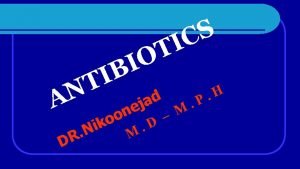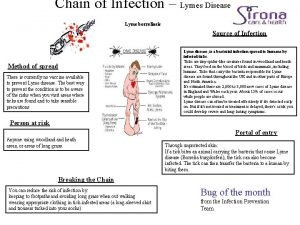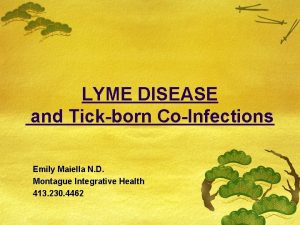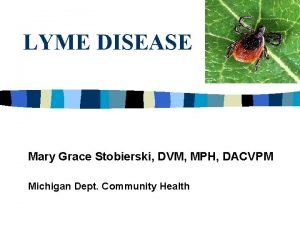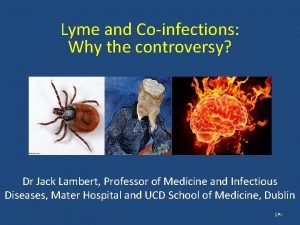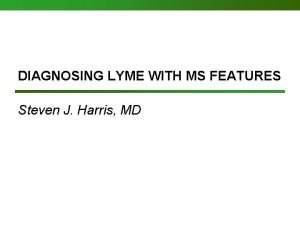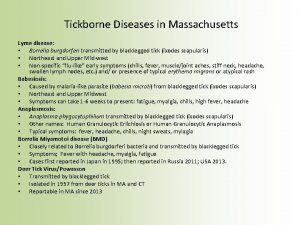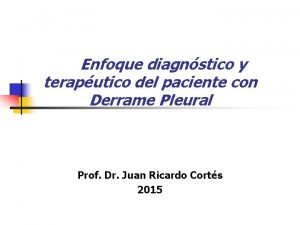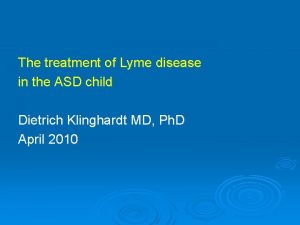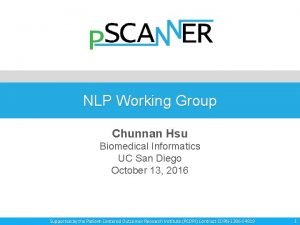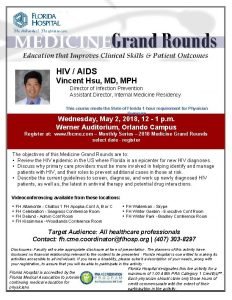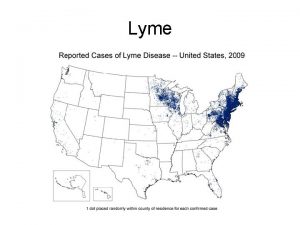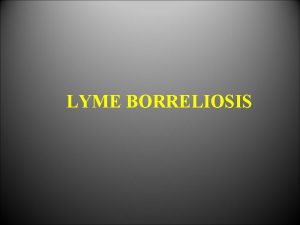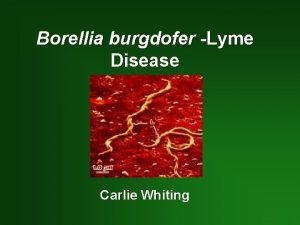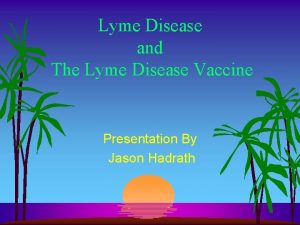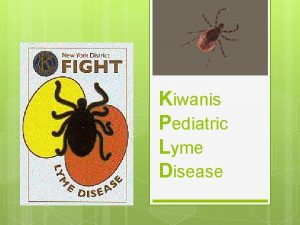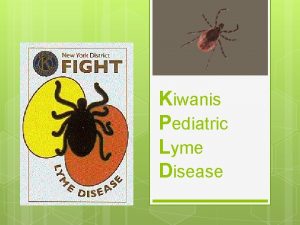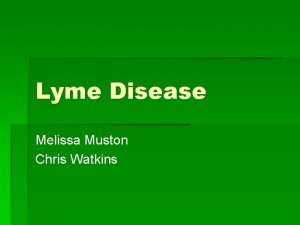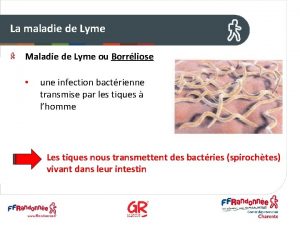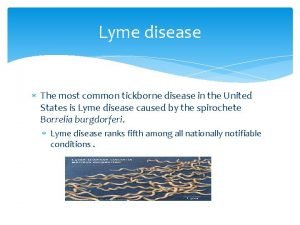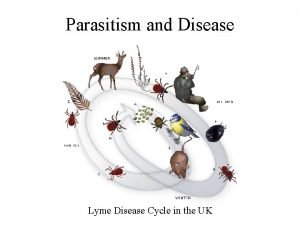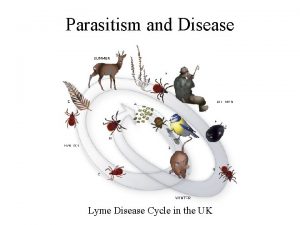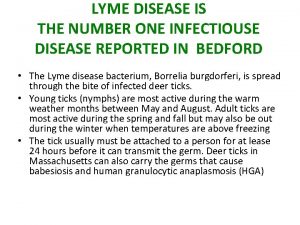Lyme disease an overview Mayla Hsu Ph D























- Slides: 23

Lyme disease: an overview Mayla Hsu, Ph. D. Science Officer June 3, 2016

What is Lyme disease? • infection caused by Borrelia burgdorferi bacterium • spread by bite of infected ticks • spectrum of symptoms, interpatient variability 3 -14 d 2 -12 wk 3 -6 mo >6 mo early local early disseminated late disseminated “chronic” “post-treatment LD syndrome” EM rash fever chills muscle ache fatigue multiple EM joint pain knee swelling muscle pain facial paralysis heart block 60% untreated chronic arthritis >1 joint swollen significant pain chronic fatigue arthritis brain “fog” insomnia psychiatric disorders malaise disability fatigue normal life impossible neuro problems no accepted clinical definition cognitive/memory problems

330, 000 Lyme disease cases annually • incidence is increasing • 96% confirmed cases in 14 states Source: CDC

Lyme disease age/sex distribution • Bimodal age distribution • Males > females Source: CDC

Lyme disease is seasonal Source: CDC

Lyme disease treatment Depends on patient’s age and disease stage Antibiotics Oral amoxicillin for ages < 9 years Oral doxycycline for ages ≥ 9 years Intravenous ceftriaxone (Rocephin) Oral ceftin Treatment duration (CDC guidelines) Localized infection: 14 d oral Early disseminated: 21 d oral Acrodermatitis (Europe): 30 d oral Lyme arthritis: 30 -60 d oral Late/severe disease: intravenous, months? Most are cured ≥ 10 -15% fail treatment Post treatment LD syndrome Persistent symptoms Role of long-term ABx? Controversial, no bacteria found Autoimmune disease?

Lyme disease diagnostics -1 CDC: two-step (“ 2 -tier”) test using patient blood 1. ELISA – enzyme-linked immunosorbent assay • patient’s serum has antibodies that recognize Lyme bacteria • ELISA plate coated with Lyme bacteria pieces (“sonicate”) • antibodies stick to ELISA plate • chemical binds antibody-bacteria complex color, read by machine Problem: not specific enough

Lyme disease diagnostics -2 CDC: two-step (“ 2 -tier”) test using patient blood 2. Western blot • patient’s serum has antibodies that recognize Lyme bacteria • bacterial protein separated on gel, proteins differ by size • separated proteins transferred to nitrocellulose • patient serum is added • if antibodies present, they stick “bands” are colored patient sera B. burgdorferi protein gel NC Western blot Problems: laborious, insensitive, errors, subjective

Problems with 2 -tier Lyme disease blood test 1. ELISA • not specific, other infections may also give positive result 2. Western blot • for Ig. M, 2 of 3 possible bands required • for Ig. G, 5 of 10 possible bands required • bacteria is only transiently in blood, antibody levels may vary Diagnostic dilemma Positive = positive Negative = ? Need better diagnostic tests! Diagram source: CDC

Lyme disease transmission: tick bites Blacklegged tick (vector): Ixodes scapularis Bacterium (pathogen): Borrelia burgdorferi Other Ixodes ticks: I. ricinus, I. pacificus Other Borrelia bacteria: B. miyamotoi, B. afzelii nomenclature convention Genus species e. g. Santarella scott abbreviated as S. scott I. scapularis + I. pacificus • vectors of B. burgdorferi • in 49. 2% of US counties, 43 states Source: Eisen RJ 2016 J Med Entomol

Tick biology and the transmission of Lyme disease • Transmit more pathogens than any other blood-feeding arthropod • bacteria, protozoa, viruses • Split from insects >500 million y ago • Homo genus evolves 2. 5 million y • H. sapiens 200, 000 y • Specialized adaptations I. scapularis • flexible cuticle that expands • 100 X body weight increase during feeding • saliva includes anesthesia, cement, anticoagulants • hemoglobin digestion recycling heme egg yolk • sensing organs Gulia-Nuss M, 2016 Nat Comm

Ticks up close: scanning electron microscope Koedel U 2015 Nat Rev Neurol a. Sensory palp: hypostome (anchor), chelicerae (teeth/saw) b. Haller’s organ: major sensory appendage • detectors for odor, movement, temperature, light (weak) Three blood meals Hosts: chipmunk mouse bird lizard deer human Stafford K 2007 CT Agr Stn Bull

Tick life cycle is tied to host availability Stafford K 2007 CT Agr Stn Bull

Borrelia burgdorferi: the bacterium • • • spirochete unusually long, moves with corkscrew motility absolutely required to cause disease inability to make many nutrients, energy scavenger unusual genetics • DNA is on many separate pieces, some linear, some circles • genes can jump from one bacteria to another (prophage) • ~30% genes differ from other bacteria, unknown functions • hard to grow in lab culture (in vitro) Koedel U 2015 Nat Rev Neurol, Brisson D 2012 Ann Rev Genet

Borrelia burgdorferi motility due to flagellae • • • internal and external flagellae escape immune attack swims through viscous fluid responds to chemical cues “runs” and “tumbles” mutations nonpathogenic Rosa P, 2005 Nat Rev Microbiol

B. burgdorferi changes its outer surface proteins Hiding from the immune system, changes in temp, p. H, nutrients A moving target • Osp. A (adhesin) in tick midgut • Osp. C turns on in tick salivary gland • required to infect mammals (~weeks) • Vls. E turns on, then changes • antibodies to Vls. E change with disease • diagnostic or prognostic? Tilly K 2008 Inf Dis Clin N Am Jacek E 2016 J Immunol

Lyme disease pathogenesis or How does Borrelia burgdorferi make me sick? Inflammation is a response to infectious microbes • cytokines – signalling chemicals • turn on/off, recruit immune cells • fever, pain, fatigue • “off” signal may be defective • always “on” • tissue damage (e. g. heart), edema • cell damage in joints, nerve cells Immune response may be inappropriate/inadequate • inability to contain Borrelia • aberrant response

Lyme disease prevention Low tech • prevent tick bites • tick checks and removal • showers after being outdoors • clothes in dryer Medium tech • bug spray including DEET • permethrin-treated clothes • tick-treat yards, playing fields High tech • vaccine did not work well and caused arthritis in some • newer vaccine candidates in the works

Gaps in knowledge: research topics Bacteriology • B. burgdorferi changes in various hosts, tissues novel targets? • do persister forms exist in animal models or in humans? • discovery of new antibiotics and new combinations of antibiotics Diagnostics • a big hole • new diagnostics not based on antibodies? • prognostic markers? PTLDS gene signatures? Animal model$ • mouse models that mimic human disease • macaque model may be very useful • steroids reduce inflammatory lesions • in vivo immune response studies

Gaps in knowledge: research topics Ticks • global survey and count of LD cases worldwide • Europe/Asia/S America/Australia? • co-infections? Babesia, Ehrlichia, Tularemia, viruses? Patients • PTLDS ≠ cured. Different genetics? • immunological profile for LD and PTLDS • clinical trials of new drug combinations that are well-controlled • Placebos? Blinded trials? Full disclosure? Matched controls? Randomized?

Evidence-based research and GLA Peer-review of grant proposals Peer-reviewed research journal publications scientific leadership criticize bad work recognize good science publish in high-profile journals earn respect of biomedical research community they will come to us for funding we will get answers to our questions donor interest media attention

Apply critical thinking to scientific inquiry

Thank you!
 Azlocillin lyme disease
Azlocillin lyme disease Chain of infection for lyme disease
Chain of infection for lyme disease Sarsaparilla lyme
Sarsaparilla lyme What disease is caused by treponema pallidum
What disease is caused by treponema pallidum Tick map
Tick map Dr jack lambert lyme disease
Dr jack lambert lyme disease Mayla lacrosse
Mayla lacrosse Dr steven harris lyme
Dr steven harris lyme Point o woods beach
Point o woods beach Met office weather selsey
Met office weather selsey Borrelia burgdorferi cdc
Borrelia burgdorferi cdc Ttanos
Ttanos Criterios de light exudado y trasudado
Criterios de light exudado y trasudado Rizol gamma biopure
Rizol gamma biopure Communicable disease and non communicable disease
Communicable disease and non communicable disease Ucsd vpn
Ucsd vpn 1. what game do the members of the joy luck club play?
1. what game do the members of the joy luck club play? Jtag bootloader
Jtag bootloader Kompetenzstrukturmodell deutsch grundschule
Kompetenzstrukturmodell deutsch grundschule Jj thomson
Jj thomson Dr te-shao hsu
Dr te-shao hsu Teori francis hsu tentang psikososiogram
Teori francis hsu tentang psikososiogram Vincent hsu md
Vincent hsu md Chun-nan hsu
Chun-nan hsu
